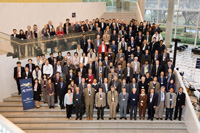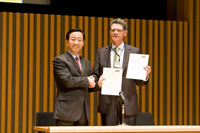 |
 |
|||||||||||||
|
|||||||||||||
|
|||||||||||||
|
In a venue that many ILC people know very well from last year's TILC meeting, the Epochal Conference Center in Tsukuba, Japan, another meeting is underway that may well change the course of physics research for scientists from Europe and Asia. The Asia Europe Physics Summit ASEPS covers all areas of physics research, from nanotechnology and energy to medical research and accelerator development. It goes even further than that: it looks at the history of collaboration between Asia and Europe and combines lessons learnt from the past with plans for future projects like the ILC. Follow it live via videoconference; instructions are given below. The organisers, CNRS (Centre National de la Recherche Scientifique) in France and by JSPS (Japan Society for the Promotion of Science) in Japan with the support of the European Physical Society and the Association of the Asia-Pacific Physical Societies, hope that the meeting brings the two regions on one page as far as the common scientific interests of European and Asian countries in various research fields are concerned. Large infrastructures are given special emphasis. On 24 March, the first day of the meeting, Jie Zhang, President of AAPPS, and Maciej Kolwas, President of the EPS, signed the ASEPS Statement which acknowledges the importance of strengthening the existing cooperation and implementing new programmes in physics research between Asia and Europe to reach a balanced cooperation at the world level. As the ILC community knows and has been practicing for a while, any future large-scale project will be a global undertaking. All regions have to work together to make science projects a reality, and whereas there are strong working connection between Europe and the Americas and Asia and the Americas, the relationship with most room for improvement is the Europe-Asia connection. ASEPS is the first in a series of meetings to tackle this. In fact, the goal is to set up a dedicated framework that would enhance Euro-Asia collaborations in physics for the next fifteen to twenty years. “The meeting is both a showcase for physics research and a unique forum to politically address the future of research,” the organisers say. With over 200 eager participants the summit brings together the ministries, funding agencies, research institutes, industry leaders and of course the researchers in charge of large projects themselves. Check the agenda for session topics and the keynote speech. The summit also aims to involve developing countries in basic research. A poster session dedicated to projects that could benefit from an enhanced Europe-Asia connection might also convince the invited decision makers to support to ASEPS initiative. If successful, the organisers hope that the idea will spread to other disciplines like biology or chemistry. You can follow the ASEPS summit remotely by videoconference. Check this page for instructions. -- Barbara Warmbein |
|||||||||||||
| © International Linear Collider |

